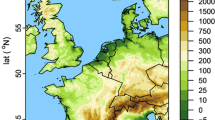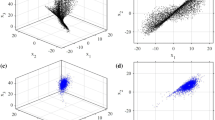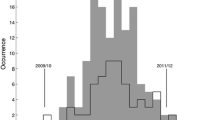Abstract
We discuss equilibrium changes in daily extreme surface air temperature and precipitation events in response to doubled atmospheric CO2, simulated in an ensemble of 53 versions of HadSM3, consisting of the HadAM3 atmospheric general circulation model (GCM) coupled to a mixed layer ocean. By virtue of its size and design, the ensemble, which samples uncertainty arising from the parameterisation of atmospheric physical processes and the effects of natural variability, provides a first opportunity to quantify the robustness of predictions of changes in extremes obtained from GCM simulations. Changes in extremes are quantified by calculating the frequency of exceedance of a fixed threshold in the 2 × CO2 simulation relative to the 1 × CO2 simulation. The ensemble-mean value of this relative frequency provides a best estimate of the expected change while the range of values across the ensemble provides a measure of the associated uncertainty. For example, when the extreme threshold is defined as the 99th percentile of the 1 × CO2 distribution, the global-mean ensemble-mean relative frequency of extremely warm days is found to be 20 in January, and 28 in July, implying that events occurring on one day per hundred under present day conditions would typically occur on 20–30 days per hundred under 2 × CO2 conditons. However the ensemble range in the relative frequency is of similar magnitude to the ensemble-mean value, indicating considerable uncertainty in the magnitude of the increase. The relative frequencies in response to doubled CO2 become smaller as the threshold used to define the extreme event is reduced. For one variable (July maximum daily temperature) we investigate this simulated variation with threshold, showing that it can be quite well reproduced by assuming the response to doubling CO2 to be characterised simply as a uniform shift of a Gaussian distribution. Nevertheless, doubling CO2 does lead to changes in the shape of the daily distributions for both temperature and precipitation, but the effect of these changes on the relative frequency of extreme events is generally larger for precipitation. For example, around one-fifth of the globe exhibits ensemble-mean decreases in time-averaged precipitation accompanied by increases in the frequency of extremely wet days. The ensemble range of changes in precipitation extremes (relative to the ensemble mean of the changes) is typically larger than for temperature extremes, indicating greater uncertainty in the precipitation changes. In the global average, extremely wet days are predicted to become twice as common under 2 × CO2 conditions. We also consider changes in extreme seasons, finding that simulated increases in the frequency of extremely warm or wet seasons under 2 × CO2 are almost everywhere greater than the corresponding increase in daily extremes. The smaller increases in the frequency of daily extremes is explained by the influence of day-to-day weather variability which inflates the variance of daily distributions compared to their seasonal counterparts.















Similar content being viewed by others
References
Allen M, Ingram W (2002) Constraints on future changes in climate and the hydrological cycle. Nature 419:224–232
Allen M, Stott P, Mitchell J, Schnur R, Delworth T (2000) Quantifying the uncertainty in forecasts of anthropogenic climate change. Nature 407:617–620
Bhaskaran B, Mitchell J (1998) Simulated changes in southeast Asian monsoon precipitation resulting from anthropogenic emissions. Int J Climatol 18:1455–1462
Boer GJ, Yu B (2003) Dynamical aspects of climate sensitivity. Geophys Res Lett 30:1135
Bonsal B, Zhang X, Vincent L, Hogg W (2001) Characteristics of daily and extreme temperatures over Canada. J Climate 14:1959–1976
Brabson B, Lister D, Jones P, Palutikof J (2005) Soil moisture and predicted spells of extreme temperatures in Britain. J Geophys Res 110:D05104
Carnell R, Senior C (1998) An assessment of measures of storminess: simulated changes in Northern Hemisphere winter due to increasing CO2. Clim Dyn 14:369–383
Christensen J, Christensen O (2003) Severe summertime flooding in Europe. Nature 421:805
Clark R, Brown S, Murphy J (2006) Modelling northern hemisphere summer heat extreme changes and their uncertainties using a physics ensemble of climate sensitivity experiments. J Climate (in press)
Collins M, Booth B, Harris G, Murphy J, Sexton D, Webb M (2006) Towards quantifying uncertainty in transient climate change. Clim Dyn (in press)
Cox P, Betts R, Jones C, Spall S, Totterdell I (2000) Acceleration of global warming due to carbon-cycle feedbacks in a coupled climate model. Nature 408:184–187
Cubasch U, Santer B, Hellbach A, Hegerl G, Höck H, Maier-Reimer E, Mikolajewicz U, Stössel A, Voss R (1994) Monte Carlo climate change forecasts with a global coupled ocean–atmosphere model. Clim Dyn 10:1–19
Cubasch U, Meehl G, Boer G, Stouffer R, Dix M, Noda A, Senior C, Raper S, Yap K (2001) Projections of future climate change. In: Houghton J, Ding Y, Griggs D, Noguer M, van der Linden P, Dai X, Maskell K, Johnson C (eds) Climate change 2001: the scientific basis. Cambridge University Press, London, pp 525–582
Durman C, Gregory J, Hassell D, Jones R, Murphy J (2001) A comparison of extreme European daily precipitation simulated by a global and regional climate model for present and future climates. Q J R Meteorol Soc 127:1005–1015
Easterling D, Meehl G, Parmesan C, Changnon S, Karl T, Mearns L (2000) Climate extremes: observations, modeling and impacts. Science 289:2068–2074
Emori S, Brown S (2005) Dynamic and thermodynamic changes in mean and extreme precipitation under change climate. Geophys Res Lett 32:L17706
Frich P, Alexander L, Della-Marta P, Gleason B, Haylock M, Klein Tank A, Peterson T (2002) Observed coherent changes in climatic extremes during the second half of the twentieth century. Clim Res 19:193–212
Furrer R, Sain S, Nychka D, Meehl G (2006) Multivariate Bayesian analysis of atmosphere-ocean general circulation models. Environ Ecol Stat (in press)
Giorgi F, Francisco R (2000) Evaluating uncertainties in the prediction of regional climate change. Geophys Res Lett 27:1295–1298
Giorgi F, Mearns L (2002) Calculation of average, uncertainty range and reliability of regional climate changes from AOGCM simulations via the “Reliability Ensemble Averaging” (REA) method. J Climate 15:1141–1158
Giorgi F, Hewitson B, Christensen J, Hulme M, Von Storch H, Whetton P, Jones R, Mearns L, Fu C (2001) Regional climate information - evaluation and projections. In: Houghton J, Ding Y, Griggs D, Noguer M, van der Linden P, Dai X, Maskell K, Johnson C (eds) Climate change 2001: the scientific basis. Cambridge University Press, London, pp 583–638
Gordon C, Cooper C, Senior C, Banks H, Gregory J, Johns T, Mitchell J, Wood R (2000) The simulation of SST, sea ice extents and ocean heat transports in a version of the Hadley Centre coupled model without flux adjustments. Clim Dyn 16:147–168
Gregory J, Mitchell J (1995) Simulation of daily variability of surface temperature and precipitation over Europe in the current and 2×CO2 climates using the UKMO climate model. Q J R Meteorol Soc 121:1451–1476
Gregory J, Mitchell J, Brady A (1997) Summer drought in northern mid-latitudes in a time-dependent CO2 climate experiment. J Climate 10:662–686
Hennessy K, Gregory J, Mitchell J (1997) Changes in daily precipitation under enhanced greenhouse conditions. Clim Dyn 13:667–680
Hewitt C, Mitchell J (1997) Radiative forcing and response of a GCM to ice age boundary conditions: cloud feedback and climate sensitivity. Clim Dyn 13:821–834
Hewitt C, Senior C, Mitchell J (2001) The impact of dynamic sea-ice on the climatology and climate sensitivity of a GCM: a study of past, present and future climates. Clim Dyn 17:655–668
Horton E, Folland C, Parker D (2001) The changing incidence of extremes in worldwide and Central England temperatures to the end of the twentieth century. Clim Change 50:267–295
Huntingford C, Jones R, Prudhomme C, Lamb R, Gash J, Jones D (2003) Regional climate-model predictions of extreme rainfall for a changing climate. Q J R Meteorol Soc 129:1607–1621
Jones R (2000) Managing uncertainty in climate change projections—issues for impact assessment. Clim Change 45:403–419
Jones P, Reid P (2001) Assessing future changes in extreme precipitation over Britain using regional climate model integrations. Int J Climatol 21:1337–1356
Jones P, Horton E, Folland C, Hulme M, Parker D, Basnett T (1999) The use of indices to identify changes in climate extremes. Clim Change 42:131–149
Karl T, Knight R (1997) The 1995 Chicago heat wave: how likely is a recurrence? Bull Amer Meteor Soc 78:1107–1119
Karl T, Nicholls N, Gregory J (1997) The coming climate. Sci Am 276:54–59
Kharin V, Zwiers F (2000) Changes in the extremes in an ensemble of transient climate simulations with a coupled atmosphere-ocean GCM. J Climate 13:3760–3788
Kharin V, Zwiers F (2005) Estimating extremes in transient climate change simulations. J Climate 18:1156–1173
Kiktev D, Sexton D, Alexander L, Folland C (2003) Comparison of modelled and observed trends in indices of daily climate extremes. J Climate 16:3560–3571
Lambert S, Boer G (2001) CMIP1 evaluation and intercomparison of coupled climate models. Clim Dyn 17:83–106
Manabe S, Stouffer R, Spelman M, Bryan K (1991) Transient responses of a coupled ocean-atmosphere model to gradual changes of atmospheric CO2. Part I: annual mean response. J Climate 4:785–818
Marsh TJ (2001) The 2000/01 floods in the UK- a brief overview. Weather 56:343–345
Meehl G, Tebaldi C (2004) More intense, more frequent, and longer lasting heat waves in the 21st century. Science 305:994–997
Meehl G, Karl T, Easterling D, Changnon S, Pielke R, Changnon D, Evans J, Groisman P, Knutson T, Kunkel K, Mearns L, Parmesan C, Pulwarty R, Root T, Sylves R, Whetton P, Zwiers F (2000a) An introduction to trends in extreme weather and climate events: observations, socioeconomic impacts, terrestrial ecological impacts and model projections. Bull Am Meteor Soc 81:413–416
Meehl G, Zwiers F, Evans J, Knutson T, Mearns L, Whetton P (2000b) Trends in extreme weather and climate events: issues related to modeling extremes in projections of future climate change. Bull Am Meteor Soc 81:427–436
Meehl G, Tebaldi C, Nychka D (2004) Changes in frost days in simulations of 21st century climate. cd 23:495–511
Meehl G, Arblaster J, Tebaldi C (2005) Understanding future patterns of increased precipitation intensity in climate model simulations. Geophys Res Lett 32:L18719
Mitchell J, Wilson C, Cunnington W (1987) On CO2 climate sensitivity and model dependence of results. Q J R Meteorol Soc 113:293–322
Murphy J, Sexton D, Barnett D, Jones G, Webb M, Collins M, Stainforth D (2004) Quantification of modelling uncertainties in a large ensemble of climate change simulations. Nature 430:768–772
New M, Hulme M, Jones PD (1999) Representing twentieth-century space-time climate variability. part I: development of a 1961-90 mean monthly terrestrial climatology. J Climate 12:829–856
Palmer T (2001) A nonlinear dynamical perspective on model error: a proposal for non-local stochastic-dynamic parametrization in weather and climate prediction models. Q J R Meteorol Soc 127:279–303
Palmer T, Räisänen J (2002) Quantifying the risk of extreme seasonal precipitation events in a changing climate. Nature 415:512–514
Parmesan C, Root T, Willig M (2000) Impacts of extreme weather and climate on terrestrial biota. Bull Am Meteor Soc 81:443–450
Pittock A, Jones R, Mitchell C (2001) Probabilities will help us plan for climate change. Nature 413:249
Pope V, Galliani M, Rowntree P, Stratton R (2000) The impact of new physical parametrizations in the Hadley Centre climate model: HadAM3. Clim Dyn 16:123–146
Reilly J, Stone P, Forest C, Webster M, Jacoby H, Prinn R (2001) Uncertainty and climate change assessments. Science 293:430–433
Rowell D, Jones R (2006) The causes and uncertainty in future summer drying over Europe. Clim Dyn (Submitted)
Schär C, Vidale P, Lüthi D, Frei C, Häberli C, Liniger M, Appenzeller C (2004) The role of increasing temperature variability in European summer heatwaves. Nature 427:332–336
Senior C, Jones R, Lowe J, Durman C, Hudson D (2002) Predictions of extreme precipitation and sea-level rise under climate change. Phil Trans R Soc Lond A 360:1301–1311
Simmons A, Burridge D (1981) An energy and angular momentum conserving finite difference scheme with hybrid coordinates. Mon Weather Rev 109:758–766
Stainforth D, Aina T, Christensen C, Collins M, Faull N, Frame D, Kettleborough J, Knight S, Martin A, Murphy J, Piani C, Sexton D, Smith L, Spicer R, Thorpe A, Allen M (2005) Uncertainty in predictions of the climate response to rising levels of greenhouse gases. Nature 433:403–406
Stocker T, Clarke G, Le Treut H, Lindsen R, Meleshko V, Mugara R, Palmer T, Pierrehumbert R, Sellers P, Trenberth K, Willebrand J (2001) Physical climate processes and feedbacks. In: Houghton J, Ding Y, Griggs D, Noguer M, van der Linden P, Dai X, Maskell K, Johnson C (eds) Climate change 2001: the scientific basis. Cambridge University Press, London, pp 417–470
Stott P, Kettleborough J (2002) Origins and estimates of uncertainty in predictions of twenty-first century temperature rise. Nature 416:723–726
Stott P, Stone D, Allen M (2004) Human contribution to the European heat wave of 2003. Nature 432:610–614
Tebaldi C, Arblaster J, Hayhoe K, Meehl G (2006) Going to the extremes: an intercomparison of model-simulated historical and future changes in extreme events. Clim Change (in press)
Tebaldi C, Smith R, Nychka D, Mearns L (2005) Quantifying uncertainty in projections of regional climate change: a Bayesian approach to the analysis of multi-model ensembles. J Climate 18:1524–1540
Visser H, Folkert R, Hoekstra J, de Wolff J (2000) Identifying key sources of uncertainty in climate change projections. Clim Change 45:421–457
Webb M, Senior C, Sexton D, Ingram W, Williams K, Ringer M, McAvaney B, Colman R, Soden B, Gudgel R, Knutson T, Emori S, Ogura T, Tsushima Y, Andronova N, Li B, Musat I, Bony S, Taylor K (2006) On the contribution of local feedback mechanisms to the range of climate sensitivity in two GCM ensembles. Clim Dyn (in press)
Wehner M (2004) Predicted twenty-first-century changes in seasonal extreme precipitation events in the Parallel Climate Model. J Climate 17:4281–4290
Weisheimer A, Palmer T (2005) Changing frequency of occurrence of extreme seasonal temperatures under global warming. Geophys Res Lett 32:L20721
Wetherald R, Manabe S (1999) Detectability of summer dryness caused by greenhouse warming. Clim Change 43:495–511
Williams K, Ringer M, Senior C (2003) Evaluating the cloud response to climate change and current climate variability. Clim Dyn 20:705–721
Xie P, Arkin PA (1998) Global monthly precipitation estimates from satellite-observed outgoing longwave radiation. J Climate 11:137–164
Zwiers F (2002) The 20-year forecast. Nature 416:690–691
Zwiers F, Kharin V (1998) Changes in the extremes of the climate simulated by CCC GCM2 under CO2 doubling. J Climate 11:2200–2222
Acknowledgements
Thanks go to Gareth S. Jones for his assistance with the production of the HadSM3 ensemble, and to two anonymous reviewers for constructive comments which helped us improve the manuscript. This work was funded by the UK Department of the Environment, Food and Rural Affairs, under the Climate Prediction Programme (Contract PECD 7/12/37). This paper is British Crown Copyright.
Author information
Authors and Affiliations
Corresponding author
Rights and permissions
About this article
Cite this article
Barnett, D.N., Brown, S.J., Murphy, J.M. et al. Quantifying uncertainty in changes in extreme event frequency in response to doubled CO2 using a large ensemble of GCM simulations. Clim Dyn 26, 489–511 (2006). https://doi.org/10.1007/s00382-005-0097-1
Received:
Accepted:
Published:
Issue Date:
DOI: https://doi.org/10.1007/s00382-005-0097-1




